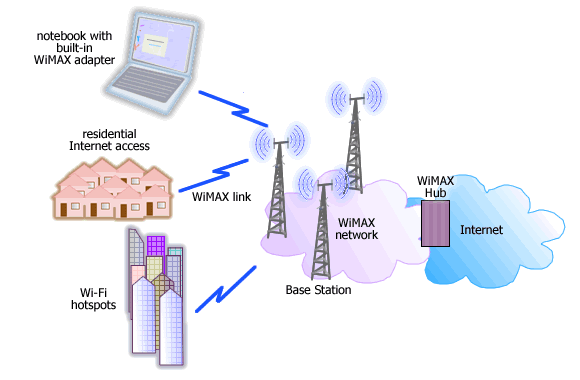Internet Access Guide : WiMAX

Picture: WiMAX vision
WiMAX provides broadband Internet connection wirelessly,
alternative backhaul for Wi-Fi hotspots, and
T1/E1 lines to business subscribers.
The emergence of WiMAX (Wireless Interoperability for Microwave Access) as
a broadband wireless access (BWA) technology adds another
alternative for users to access broadband services, specifically
high speed Internet (HSI). WiMAX has the
capability to deliver triple play services, i.e. voice, video and
data over microwave RF (Radio Frequency) spectrum to stationary or
moving users making broadband available anywhere. That is what
leads WiMAX being touted as a Personal Broadband technology. Above
all, the fact that WiMAX is an international standard is the prime
advantage of WiMAX over previous BWA systems such as LMDS and MMDS
which experienced limited adoption and deployment.
There are two flavors of WiMAX, i.e. Fixed WiMAX and Mobile
WiMAX. Fixed WiMAX is developed based on the IEEE 802.16-2004
standard and is optimized for fixed and nomadic applications in
LOS and NLOS environments. Mobile WiMAX is based on the IEEE
802.16e standard and targeted primarily for portable and mobile
applications in NLOS environment. However, Mobile WiMAX systems
also can
provide fixed and nomadic access. Mobile WiMAX incorporates
additional features
crucial to mobile applications: handoff, flexible power management (sleep mode and idle
mode), channel bandwidth scalability (SOFDMA),
fractional frequency reuse, and better NLOS performance
and indoor penetration.
The WiMAX Forum, the organization that promotes WiMAX
interoperability between vendors, develops WiMAX
system profiles
based on the IEEE 802.16 standards harmonized with
industry trends, market demands, and international regulations.
Because the 802.16 standard only defines physical layer (PHY) and
MAC sublayer air interface specifications, the WiMAX Forum also creates
guidelines for an end-to-end WiMAX network architecture, roaming, and
integration with different networks (such as Wi-Fi and 3G), taking
a large part from IETF Internet Protocol (IP) - related RFCs, other
relevant IEEE standards, DOCSIS-based security
protocols, and 3GPP's IMS fixed
mobile convergence concept.
|